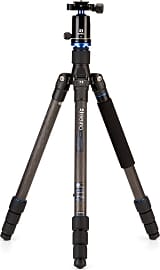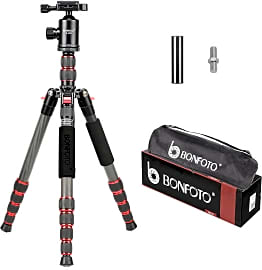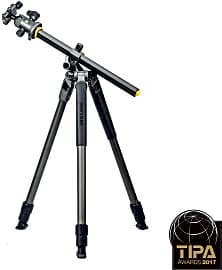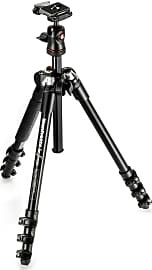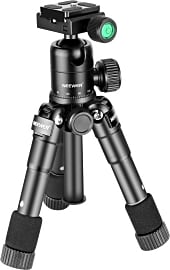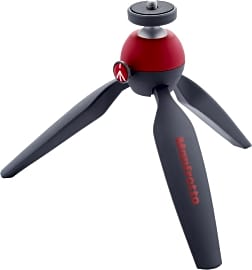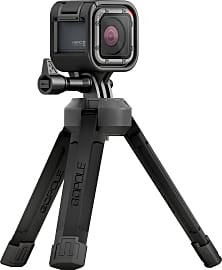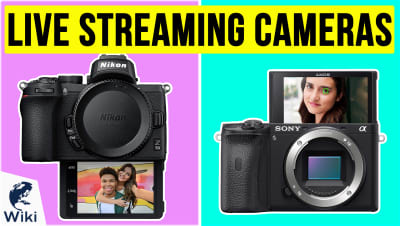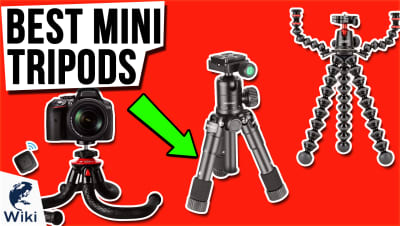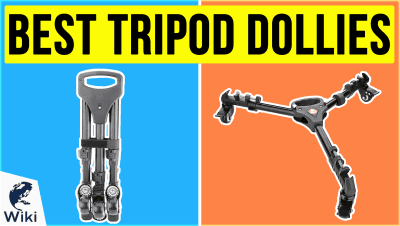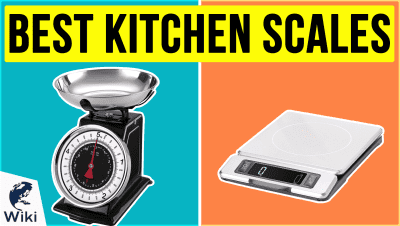The 10 Best Compact Tripods

This wiki has been updated 33 times since it was first published in February of 2017. Whether you're snapping photos at home or traveling the globe, there's no reason why you can't manage a steady shot in any situation using your camera, camcorder, or cell phone, if you have one of these nifty, compact tripods. These are designed to fit easily into backpacks and carry-on bags, and offer folding legs, adjustable angles, and a range of available height options. When users buy our independently chosen editorial choices, we may earn commissions to help fund the Wiki.
Editor's Notes
September 09, 2020:
Whether you actually want to use your tripod for travel will play a big part in deciding among models. Certain offerings, like the GoPole Base 15 or the Manfrotto Pixi Mini, are no-brainers for packing without much fuss, but their use is going to be limited to tabletops. That makes these ideal for influencers and other types who livestream and don't need to support too much weight. The Neewer Desktop Macro is a step up in this regard, and has enough strength to serve nature photographers who know they do most of their macro work very close to the ground, and only need something small for the task.
If space isn't as big of a concern, but that ability to get close to the ground is, the Bonfoto B690C Lightweight lets you invert its central column to shoot just inches above the soil without needing to make massive adjustments to the legs. Of course, the big names like Manfrotto and Benro are where you'll want to go if you use your tripod on a frequent basis and want something that will last. The Benro Travel Angel 2 Series and the Manfrotto 055 Four-Section both boast carbon fiber construction that keeps them lightweight and durable.
October 03, 2019:
Availability issues with a pair of models necessitated their removal, namely the Bonfoto B671C and the PolarPro Trippler. Bonfoto had a nice alternative available in the 671A that slotted in at number six. It could be a little shorter when fully collapsed, but at just over three pounds, it still makes a pretty portable choice.
That balance between just how compact one of these tripods is and things like their maximum height and carrying weight remains the most important factor in our ranking. That balance is perhaps best struck by our number one pick, the Manfrotto 055 in carbon fiber, which is a mere 54cm long when broken down. It also includes some of the most durable and reliable flip locks in the industry. From my experience, these are much easier to use than twist locks, which often feel as though they require overtightening, which will wear down lesser versions over time.
We also made it a point to include some tabletop options for small cameras or lights used by live streamers, and Manfrotto offers a very fine one of these, as well, for a very reasonable price.
October 18, 2018:
The updated version of Vanguard's Alta Pro seems to have some problems maintaining the kind of stability most shooters need, so it dropped a good distance down the list. Toward the top, we've added the latest Travel Angel tripod by Benro, as that company continues its ascendence in the marketplace as a significant rival for more established brands like Manfrotto.
What A Compact Tripod Can Do For You
Whether this is a model meant to hold you over until you can afford something nicer or you already have a pro-level set of sticks is actually irrelevant to our topic here.
If you’ve been a photographer for any stretch of time, chances are you already own a tripod. Whether this is a model meant to hold you over until you can afford something nicer or you already have a pro-level set of sticks is actually irrelevant to our topic here. That’s because compact tripods are a unique offering, and even if you already have several means by which you stabilize your camera, one of these more diminutive models is still a smart addition to your kit.
That’s because a compact tripod can often perform certain functions that a regular, full-sized tripod cannot. The most obvious of these is that it can get your camera closer to the ground. Even with their legs spread out, full-sized tripods can only bring your camera so close to the floor, making certain low or up angles more difficult to capture. Compact tripods, on the other hand, start out a lot closer to the ground, and when you spread them out they get extremely low.
You might be telling yourself that you never shoot low angles like that, so such an advantage would be wasted on you, but there’s another crucial benefit to a compact tripod that you could certainly use: they’re exceedingly portable. If you’re hiking into the wilderness to do some shooting, the last thing you want to do is try to figure out how to get your video tripod lashed to your camping backpack. A compact tripod is much easier to pack and will add a significantly lighter load to your haul, saving you valuable energy.
Compact tripods also make good knock-around models, as many are far less expensive than their professional counterparts. That means you can rely on your compact model as a tool for more rugged environments or shoots that could endanger your pro gear. For example, I recently shot a horror film, and one of the scenes called for a veritable bloodbath with a tripod on a dolly. I could have spent a bunch of time carefully covering my go-to sticks with plastic to prevent all that sticky fake blood from harming their joints, but I chose instead to reach for a smaller tripod I keep on hand for whenever I need a low angle. It got covered in fake blood, and I was able to wash and dry it without worrying too much if it would ever be the same. There’s freedom in that.
How To Choose The Perfect Compact Tripod
The compact tripod category contains a very wide variety of models, so choosing one from among them might turn out to be a slightly harder task than you would have imagined starting out. With an eye toward certain features and styles, however, you can easily take the options on our list and narrow them down to just one or two great models.
Screw locks are also a little bit more of a hassle then their tab-based counterparts.
Because most compact tripods have stark limits to their weight capacity compared to full-sized units, the first thing you should do when shopping for a compact tripod is ascertain the heaviest weight of your usual setup. That means grabbing your camera, your heaviest lens, and anything you might want to attach to the camera for shooting, and putting it on a scale. If you don't have a small scale like a food scale, you can hop on your regular bathroom scale without holding the camera and subtract that number from the number you see when standing on the scale with the camera in your hand. That should give you the weight of your setup. Then, make sure that the tripod you have your eye on can support at least that much weight.
Another important thing to look at is whether or not the legs of your compact model can extend. Some compact tripods are so small that they aren't even built for any kind of height, and they're intended rather for use tabletops and other flat, stable services. Any model with extendable legs will be considerably more versatile, and will probably be able to hold a heavier-set up.
Finally, take a look at the way those legs extend. Most tripods today utilize either screw locks or tab locks to secure their legs in an extended position. Screw locks are generally considered to be more durable, as there aren't any appendages susceptible to damage. Users may overtighten these, however, which can damage their ability to hold a locked position. Screw locks are also a little bit more of a hassle then their tab-based counterparts. Tab locks today are a lot stronger than they were when they first came out, as well, and as long as you don't wrench them in the wrong direction, they should hold up just fine.
Other Smart Camera Accessories
If you’re trying to reduce the size of your gear footprint as much as possible, compact tripods are a great start. There are some other accessories you can invest in, as well, that can make your photography and videography kit much smaller.
Professional sound equipment can be bulky and expensive, however, and paying someone to run it can be a costly affair.
If you shoot video, the quality of your audio is paramount. Professional sound equipment can be bulky and expensive, however, and paying someone to run it can be a costly affair. Instead, you can get a small shotgun microphone that mounts on your camera’s hot shoe. That placement allows it to cleanly pick up audio from whatever the camera is pointing at with minimal background noise.
If you find your camera strap to be too cumbersome, you can invest in any number of alternative solutions, from wrist straps to harness systems. You could also use a holster if you find that you mostly rely on one lens when you’re out shooting.
The bag you use to keep all of your gear together can go a long way toward reducing your overall footprint, as well, especially if its interior is spacious and customizable, and its overall size is relatively small. And if you’re getting a compact tripod for use in the wilderness, there are great waterproof bag options out there that warrant serious consideration.



